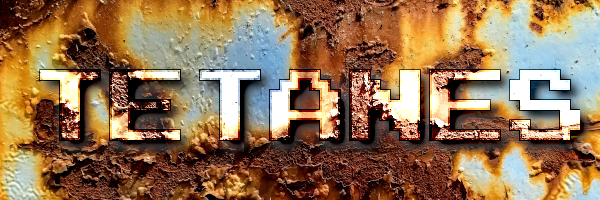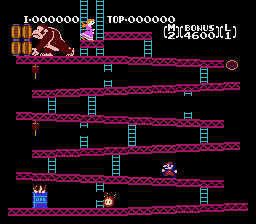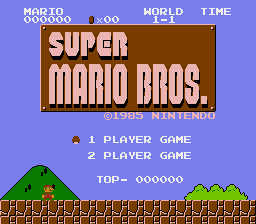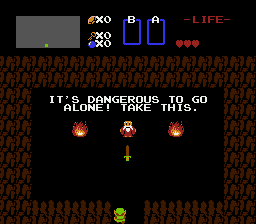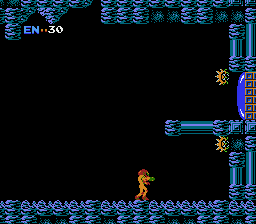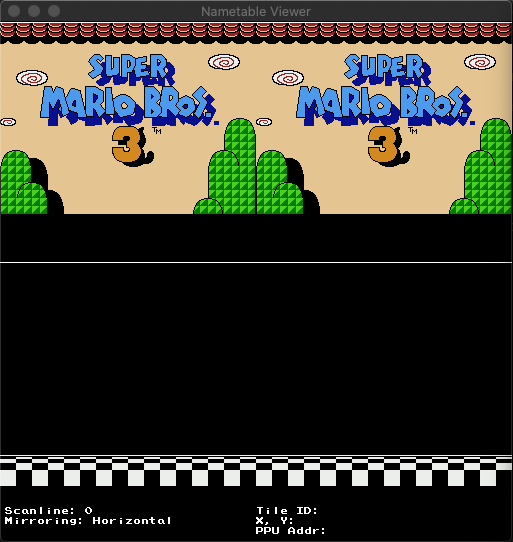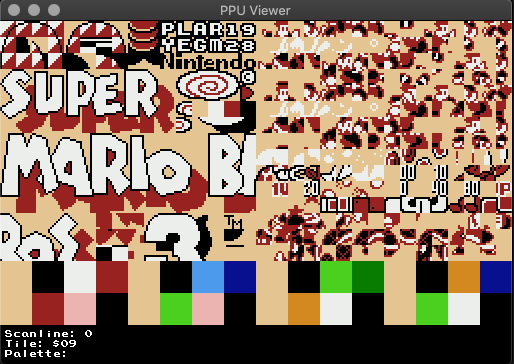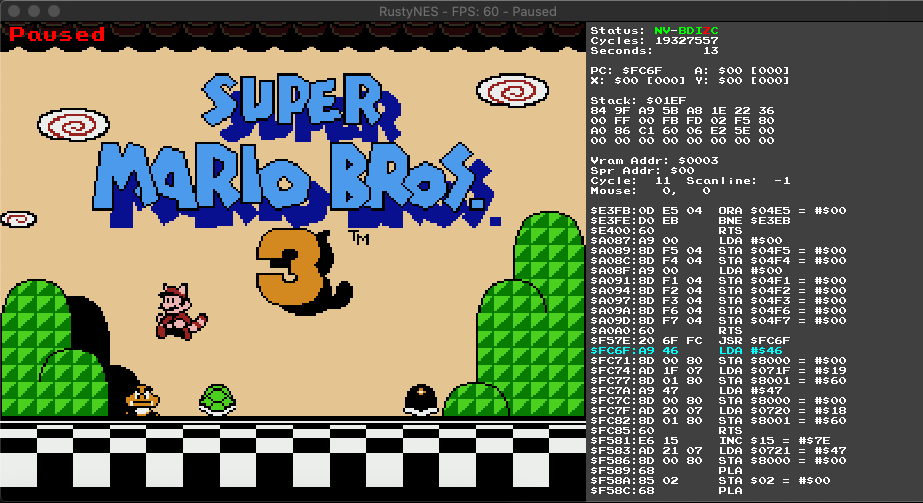📖 Summary - 🌆 Screenshots - 🚀 Getting
Started - 🛠️ Features -
photo credit for background: Zsolt Palatinus on unsplash
TetaNES is an emulator for the Nintendo Entertainment System (NES) released in
Japan in 1983 and North America in 1986, written using Rust, SDL2 and
Web Assembly.
It started as a personal curiosity that turned into a passion project. It is still a work-in-progress with new features and improvements constantly being added. It is already a fairly accurate emulator that can play most games with several debugging features.
TetaNES is also meant to showcase how great Rust is in addition to having the
type and memory-safety guarantees that Rust is known for. Many features of Rust
are leveraged in this project including complex enums, traits, trait objects,
generics, matching, and iterators.
There are a few uses of unsafe for coordinating NES components to simplify
the architecture and increase performance. The NES hardware is highly integrated
since the address and data buses are mutable global state which is normally
restricted in Rust, but is safe here given the synchronized nature of the
emulation.
TetaNES also compiles for the web! Try it out in your
browser!
The current minimum Rust version is 1.62.0.
TetaNES should run on most platforms that support Rust and SDL2. Platform
binaries will be available when 1.0.0 is released, but for the time being you
can install with cargo which comes installed with Rust.
See Installing Dependencies in pix-engine.
cargo install tetanesThis will install the latest version of the TetaNES binary to your cargo bin
directory located at either $HOME/.cargo/bin/ on a Unix-like platform or
%USERPROFILE%\.cargo\bin on Windows.
USAGE:
tetanes [FLAGS] [OPTIONS] [path]
FLAGS:
--consistent_ram Power up with consistent ram state.
-f, --fullscreen Start fullscreen.
-h, --help Prints help information
-V, --version Prints version information
OPTIONS:
--speed <speed> Emulation speed. [default: 1.0]
-s, --scale <scale> Window scale. [default: 3.0]
ARGS:
<path> The NES ROM to load, a directory containing `.nes` ROM files, or a
recording playback `.playback` file. [default: current directory]
iNES and NES 2.0 formatted ROMS are supported, though some NES 2.0
features may not be implemented.
Support for the following mappers is currently implemented or in development:
| # | Name | Example Games | # of Games1 | % of Games1 |
|---|---|---|---|---|
| 000 | NROM | Bomberman, Donkey Kong, Super Mario Bros. | ~247 | ~10% |
| 001 | SxROM/MMC1B/C | Metroid, Legend of Zelda, Tetris | ~680 | ~28% |
| 002 | UxROM | Castlevania, Contra, Mega Man | ~270 | ~11% |
| 003 | CNROM | Arkanoid, Paperboy, Pipe Dream | ~155 | ~6% |
| 004 | TxROM/MMC3/MMC6 | Kirby's Adventure, Super Mario Bros. 2/3 | ~599 | ~24% |
| 005 | ExROM/MMC5 | Castlevania 3, Laser Invasion | ~24 | <0.01% |
| 007 | AxROM | Battletoads, Marble Madness | ~75 | ~3% |
| 009 | PxROM/MMC2 | Punch Out!! | 1 | <0.01% |
| 024 | VRC6a | Akumajou Densetsu | 1 | <0.01% |
| 024 | VRC6b | Madara, Esper Dream 2 | 2 | <0.01% |
| 066 | GxROM/MxROM | Super Mario Bros. + Duck Hunt | ~17 | <0.01% |
| 071 | Camerica/Codemasters | Firehawk, Bee 52, MiG 29 - Soviet Fighter | ~15 | <0.01% |
| 155 | SxROM/MMC1A | Tatakae!! Ramen Man: Sakuretsu Choujin | 2 | <0.01% |
| ~2088 / 2447 | ~83% |
Keybindings can be customized in the configuration menu. Below are the defaults.
NES gamepad:
| Button | Keyboard | Controller |
|---|---|---|
| A | Z | A |
| B | X | B |
| A (Turbo) | A | X |
| B (Turbo) | S | Y |
| Start | Return | Start |
| Select | Right Shift | Back |
| D-Pad | Arrow Keys | Left Stick/D-Pad |
Emulator shortcuts:
| Action | Keyboard | Controller |
|---|---|---|
| Menu/Pause | Escape | Guide Button |
| About TetaNES | Ctrl-H or F1 | |
| Configuration Menu | Ctrl-C or F2 | |
| Load/Open ROM | Ctrl-O or F3 | |
| Quit | Ctrl-Q | |
| Reset | Ctrl-R | |
| Power Cycle | Ctrl-P | |
| Increase Speed by 25% | Ctrl-= | Right Shoulder |
| Decrease Speed by 25% | Ctrl-- | Left Shoulder |
| Fast-Forward 2x (while held) | Space | |
| Set Save State Slot # | Ctrl-(1-4) | |
| Save State | Ctrl-S | |
| Load State | Ctrl-L | |
| Instant Rewind | R | |
| Visual Rewind (while holding) | R | |
| Take Screenshot | F10 | |
| Toggle Gameplay Recording | Shift-V | |
| Toggle Music/Sound Recording | Shift-R | |
| Toggle Music/Sound | Ctrl-M | |
| Toggle Pulse Channel 1 | Shift-1 | |
| Toggle Pulse Channel 2 | Shift-2 | |
| Toggle Triangle Channel | Shift-3 | |
| Toggle Noise Channel | Shift-4 | |
| Toggle DMC Channel | Shift-5 | |
| Toggle Fullscreen | Ctrl-Return | |
| Toggle Vsync | Ctrl-V | |
| Toggle NTSC Filter | Ctrl-N | |
| Toggle CPU Debugger | Shift-D | |
| Toggle PPU Debugger | Shift-P | |
| Toggle APU Debugger | Shift-A |
While the CPU Debugger is open (these can also be held down):
| Action | Keyboard |
|---|---|
| Step a single CPU instruction | C |
| Step over a function | O |
| Step out of a function | Shift-O |
| Step a single scanline | Shift-L |
| Step an entire frame | Shift-F |
While the PPU Debugger is open (these can also be held down):
| Action | Keyboard |
|---|---|
| Move debug scanline up by 1 | Ctrl-Up |
| Move debug scanline up by 10 | Ctrl-Shift-Up |
| Move debug scanline down by 1 | Ctrl-Down |
| Move debug scanline down by 10 | Ctrl-Shift-Down |
Battery-backed game data and save states are stored in
$HOME/.tetanes. Screenshots are saved to the directory where TetaNES was
launched from.
The original NES hardware had semi-random contents located in RAM upon power-up
and several games made use of this to seed their Random Number Generators
(RNGs). By default, TetaNES honors the original hardware and emulates
randomized powerup RAM state. This shows up in several games such as Final Fantasy,
River City Ransom, and Impossible Mission II, amongst others. Not
emulating this would make these games seem deterministic when they weren't
intended to be.
If you would like TetaNES to provide fully deterministic emulated power-up
state, you'll need to change the ram_state setting in the configuration
menu and trigger a power-cycle or use the --ram_state flag from the
command line.
To build the project run cargo build or cargo build --release (if you want
better framerates). There is also a optimized dev profile you can use which
strikes a balance between build time and performance:
cargo build --profile dev-opt. You may need to install SDL2 libraries, see the
Installation section above for options.
Unit and integration tests can be run with cargo test. There are also several
test roms that can be run to test various capabilities of the emulator. They are
all located in the tests_roms/ directory.
Run them in a similar way you would run a game. e.g.
cargo run --release test_roms/cpu/nestest.nes
There are built-in debugging tools that allow you to monitor game state and step
through CPU instructions manually. See the Controls section for more on
keybindings.
The default debugger screen provides CPU information such as the status of the CPU register flags, Program Counter, Stack, PPU information, and the previous/upcoming CPU instructions.
The Nametable Viewer displays the current Nametables in PPU memory and allows you to scroll up/down to change the scanline at which the nametable is read. Some games swap out nametables mid-frame.
The PPU Viewer shows the current sprite and palettes loaded. You can also scroll
up/down in a similar manner to the Nametable Viewer. Super Mario Bros 3 for
example swaps out sprites mid-frame to render animations.
Logging can be set by setting the RUST_LOG environment variable and setting it
to one of trace, debug, info, warn or error prior to building the
binary. e.g. RUST_LOG=debug cargo build --release
If you get an error running a ROM that's using the supported Mapper list above, it could be a corrupted or incompatible ROM format. If you're unsure which games use which mappers, see http://bootgod.dyndns.org:7777/. Trying other versions of the same game from different sources sometimes resolves the issue.
If you get some sort of other error when trying to start a game that previously
worked, try removing any saved states from $HOME/.tetanes to ensure it's not
an incompatible savestate file causing the issue.
If you encounter any shortcuts not working, ensure your operating system does
not have a binding for it that is overriding it. macOS specifically has many
things bound to Ctrl-*.
If an an issue is not already created, please use the github issue tracker to create it. A good guideline for what to include is:
- The game experiencing the issue (e.g.
Super Mario Bros 3) - Operating system and version (e.g. Windows 7, macOS Mojave 10.14.6, etc)
- What you were doing when the error happened
- A description of the error and what happeneed
- Any screenshots or console output
- Any related errors or logs
When using the WASM version in the browser, also include:
- Web browser and version (e.g. Chrome 77.0.3865)
- cycle-accurate - Enables cycle-accurate emulation. More CPU intensive, but supports a wider range of games requiring precise timing. Disabling may improve performance on lower-end machines. Enabled by default.
- NES Formats & Run Modes
- NTSC
- PAL
- Dendy
- Headless mode
- Central Processing Unit (CPU)
- Official Instructions
- Unofficial Instructions
- Cycle Accurate
- Picture Processing Unit (PPU)
- Pixellate Filter
- NTSC Filter
- CRT Filter
- Audio Processing Unit (APU)
- Pulse Channels
- Triangle Channel
- Noise Channel
- Delta Modulation Channel (DMC)
- Player Input
- 1-2 Player w/ Keyboard or Controllers
- 3-4 Player Support w/ Controllers
- Zapper (Light Gun)
- Cartridge
- iNES Format
- NES 2.0 Format
- Complete NES 2.0 support
- Mappers
- Mapper 000 - NROM
- Mapper 001 - SxROM/MMC1B/C
- Mapper 002 - UxROM
- Mapper 003 - CNROM
- Mapper 004 - TxROM/MMC3/MMC6
- Mapper 005 - ExROM/MMC5
- Mapper 007 - AxROM
- Mapper 009 - PxROM/MMC2
- Mapper 010 - FxROM/MMC4
- Mapper 011 - Color Dreams
- Mapper 019 - Namco 163
- Mapper 023 - VRC2b/VRC4e
- Mapper 025 - VRC4b/VRC4d
- Mapper 024 - VRC6a
- Mapper 026 - VRC6b
- Mapper 034 - BNROM/NINA-001
- Mapper 064 - RAMBO-1
- Mapper 066 - GxROM/MxROM
- Mapper 068 - After Burner
- Mapper 069 - FME-7/Sunsoft 5B
- Mapper 071 - Camerica/Codemasters/BF909x
- Mapper 079 - NINA-03/NINA-06
- Mapper 155 - MMC1A
- Mapper 206 - DxROM/Namco 118/MIMIC-1
- Releases
- macOS Binaries
- Linux Binaries
- Windows Binaries
- User Interface (UI)
- SDL2
- WebAssembly (WASM) - Run TetaNES in the browser!
- Configurable keybinds and default settings
- Menus
- Configuration options
- Customize Keybinds & Controllers
- Load/Open ROM with file browser
- Recent Game Selection
- About Menu
- Config paths overrides
- Increase/Decrease Speed
- Fast-forward
- Instant Rewind (2 seconds)
- Visual Rewind (Holding R will time-travel backward)
- Save/Load State
- Auto-save
- Take Screenshots
- Gameplay Recording
- Sound Recording (Save those memorable tunes!)
- Toggle Fullscreen
- Toggle VSync
- Toggle Sound
- Toggle individual sound channels
- Toggle FPS
- Toggle Messages
- Change Video Filter
- Game Genie Support
- Command-Line
- UI Menu
- WideNES
- Network Multi-player
- Self Updater
- Testing/Debugging/Documentation
- Debugger (Displays CPU/PPU status, registers, and disassembly)
- Step Into/Out/Over
- Step Scanline/Frame
- Breakpoints
- Modify state
- Labels
- Hex Memory Editor & Debugger
- PPU Viewer
- Scanline Hit Configuration (For debugging IRQ Nametable changes)
- Nametable Viewer (background rendering)
- CHR Viewer (sprite tiles)
- OAM Viewer (on screen sprites)
- Palette Viewer
- APU Viewer (Displays audio status and registers)
- Automated ROM tests (including nestest)
- Detailed Documentation
- Logging
- Environment logging
- File logging
- Debugger (Displays CPU/PPU status, registers, and disassembly)
See the github issue tracker.
In addition to the wealth of information in the docs/ directory, I also
referenced these websites extensively during development:
TetaNES is licensed under the GPLv3 license. See the LICENSE.md file in the
root for a copy.
While this is primarily a personal project, I welcome any contributions or suggestions. Feel free to submit a pull request if you want to help out!
For issue reporting, please use the github issue tracker. You can also contact me directly at https://lukeworks.tech/contact/.
Implementation was inspiried by several amazing NES projects, without which I would not have been able to understand or digest all the information on the NES wiki.
I also couldn't have gotten this far without the amazing people over on the NES Dev Forums:
- blargg for all his amazing test roms
- bisqwit for his test roms & integer NTSC video implementation
- Disch
- Quietust
- rainwarrior
- And many others who helped me understand the stickier bits of emulation
Also, a huge shout out to OneLoneCoder for his NES and olcPixelGameEngine series as those helped a ton in some recent refactorings.





